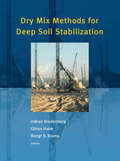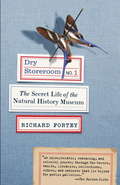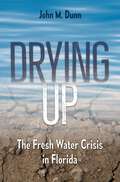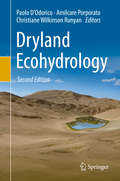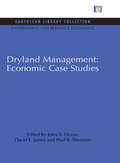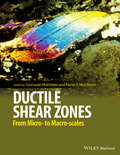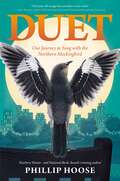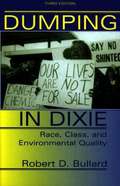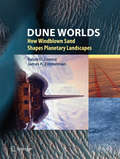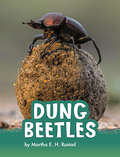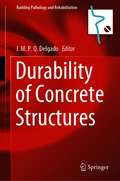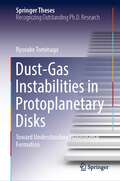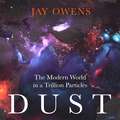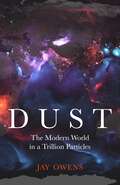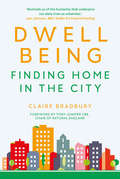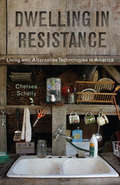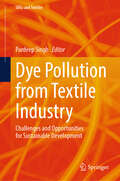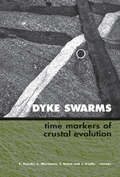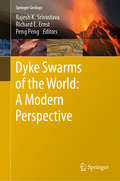- Table View
- List View
Dry Mix Methods for Deep Soil Stabilization
by Håkan Bredenberg Göran Holm Bengt B. BromsIt is a truism that we can no longer freely pick areas with the most suitable ground conditions for building purposes. Soils must often be improved in order to take the loads from buildings, roads and other objects. This volume contains papers covering a range of relevant topics and issues.
Dry Run
by Jerry YudelsonIn the Age of Scarcity now upon us, fresh water shortages are an increasingly serious global problem. With water restrictions emerging in many developed countries and water diversions for industrial, urban, and environmental reasons stirring up oceans of controversy, there is a growing thirst for innovative approaches to reducing our water footprint. Dry Run shows the best ways to manage scarce water resources and handle upcoming urban water crises. Featuring original interviews with more than twenty-five water researchers and industry experts, this book explains water issues and proposes solutions for homes, buildings, facilities, and schools. Examining the vital linkages between water, energy use, urban development, and climate change, Dry Run demonstrates best practices for achieving "net zero" water use in the built environment, including: Water conservation strategies for buildings, factories, cities, and homes Rainwater harvesting Graywater reuse and water reclamation systems Water efficiency retrofits On-site sewage treatment New water reuse and supply technologies Ideal for concerned citizens, building managers, homeowners, architects, engineers, developers, and public officials faced with charting a course in a more arid future, Dry Run overflows with practical solutions. Jerry Yudelson, PE, LEED AP, leads the Yudelson Associates consultancy and is a leading authority on green building, clean water, and sustainable development. He is the author of eleven books, including Choosing Green and Green Building A to Z.
Dry Storeroom No. 1
by Richard ForteyDry Store Room No. 1 is an intimate biography of the Natural History Museum, celebrating the eccentric personalities who have peopled it and capturing the wonders of scientific endeavour, academic rigour and imagination. This book is a kind of museum of the mind. It is my own collection, a personal archive, designed to explain what goes on behind the polished doors in the Natural History Museum. The lustre of a museum does not depend only on the artefacts or objects it contains the people who work out of sight are what keeps a museum alive. I want to bring those invisible people into the sunlight. Behind the public facade of any great museum there lies a secret domain: one of unseen galleries, locked doors, priceless specimens and hidden lives. Through the stories of the numerous eccentric individuals whose long careers have left their mark on the study of evolutionary science, Richard Fortey, former senior paleontologist at London's Natural History Museum, celebrates the pioneering work of the Museum from its inception to the present day. He delves into the feuds, affairs, scandals and skulduggery that have punctuated its long history, and formed a backdrop to extraordinary scientific endeavour. He explores the staying power and adaptability of the Museum as it responds to changes wrought by advances in technology and molecular biology -- 'spare' bones from an extinct giant bird suddenly become cutting-edge science with the new knowledge that DNA can be extracted from them, and ancient fish are tested with the latest equipment that is able to measure rises in pollution. Dry Store Room No. 1 is a fascinating and affectionate account of a hidden world of untold treasures, where every fragment tells a story about time past, by a scientist who combines rigorous professional learning with a gift for prose that sparkles with wit and literary sensibility.
Drying Up: The Fresh Water Crisis in Florida
by John M. DunnAmerica’s wettest state is running out of water. Florida—with its swamps, lakes, extensive coastlines, and legions of life-giving springs—faces a drinking water crisis. Drying Up is a wake-up call and a hard look at what the future holds for those who call Florida home. Journalist and educator John Dunn untangles the many causes of the state’s freshwater problems. Drainage projects, construction, and urbanization, especially in the fragile wetlands of South Florida, have changed and shrunk natural water systems. Pollution, failing infrastructure, increasing outbreaks of toxic algae blooms, and pharmaceutical contamination are worsening water quality. Climate change, sea level rise, and groundwater pumping are spoiling freshwater resources with saltwater intrusion. Because of shortages, fights have broken out over rights to the Apalachicola River, Lake Okeechobee, the Everglades, and other important watersheds. Many scientists think Florida has already passed the tipping point, Dunn warns. Drawing on more than one hundred interviews and years of research, he affirms that soon there will not be enough water to meet demand if “business as usual” prevails. He investigates previous and current restoration efforts as well as proposed future solutions, including the “soft path for water” approach that uses green infrastructure to mimic natural hydrology. As millions of new residents are expected to arrive in Florida in the coming decades, this book is a timely introduction to a problem that will escalate dramatically—and not just in Florida. Dunn cautions that freshwater scarcity is a worldwide trend that can only be tackled effectively with cooperation and single-minded focus by all stakeholders involved—local and federal government, private enterprise, and citizens. He challenges readers to rethink their relationship with water and adopt a new philosophy that compels them to protect the planet’s most precious resource.
Dryland Ecohydrology
by Paolo D’Odorico Amilcare Porporato Christiane Wilkinson RunyanBy combining the analysis of biotic and abiotic components of terrestrial ecosystems, this book synthesizes material on arid and semiarid landscapes, which was previously scattered among various books and journal articles. It focuses on water-limited ecosystems, which are highly sensitive to fluctuations in hydrologic conditions and, in turn, play an important role in affecting the regional water cycle. Intended as a tool for scientists working in the area of the earth and environmental sciences, this book presents the basic principles of eco-hydrology as well as a broad spectrum of topics and advances in this research field. Written by authors with diverse areas of expertise who work in arid areas around the world, the contributions describe the various interactions between the biological and physical dynamics in dryland ecosystems, ranging from basic processes in the soil-vegetation-climate system, to landscape-scale hydrologic and geomorphic processes, ecohydrologic controls on soil nutrient dynamics, and multiscale analyses of disturbances and patterns
Dryland Management: Economic Case Studies (Environmental and Resource Economics Set)
by David E. James John A. Dixon Paul B. ShermanDrylands are a sizeable part of the world's potentially arable land. They vary from the hyper-arid regions of the classic deserts of Africa and Asia to the more common semi-arid and sub-humid areas that support extensive agricultural systems dependent on rainfall or irrigation. Following their successful and innovative work The Economics of Dryland Management the editors have assembled twenty case studies from nine countries in the continents of Africa, Asia, North America and Australia. They help to explore more fully the costs of land degradation and illustrate the economics of reclamation, rehabilitation and prevention. The cases in this book present a rich, varied and readable survey of a wide range of drylands and their resources. Originally published in 19990
Dryland Social-Ecological Systems in Changing Environments
by Bojie Fu Mark Stafford-SmithThis open access book prepared by a joint working group committed to critical research on dryland social-ecological systems (SESs) presents a timely synthesis of up-to-date knowledge in various thematic fields relevant to dryland SESs. It aims to organize key salient concepts and establish a conceptual framework relevant to the interdisciplinary and cross-cultural understanding of dryland SESs, which have specific contexts and a geographically representative structure. Through synthesizing research across the world and analyzing scientific evidence for good practices, it has the potential to promote collaboration among global researchers as well as communication with policy makers, managers, and practitioners for dryland ecosystem management to promote sustainability. It calls for synergies between different sectors and countries to achieve Sustainable Development Goals in drylands.
Drylands Facing Change: Interventions, Investments and Identities (Earthscan Studies in Natural Resource Management)
by Angela Kronenburg García, Tobias Haller, Han van Dijk, Cyrus Samimi, Jeroen WarnerThis edited volume examines the changes that arise from the entanglement of global interests and narratives with the local struggles that have always existed in the drylands of Africa, the Middle East, and Central Asia and Inner Asia. Changes in drylands are happening in an overwhelming manner. Climate change, growing political instability, and increasing enclosures of large expanses of often common land are some of the changes with far-reaching consequences for those who make their living in the drylands. At the same time, powerful narratives about the drylands as ‘wastelands’ and their ‘backward’ inhabitants continue to hold sway, legitimizing interventions for development, security and conservation, informing re-emerging frontiers of investment (for agriculture, extraction, infrastructure), and shaping new dryland identities. The chapters in this volume discuss the politics of change triggered by forces as diverse as the global land and resource rush, the expansion of new Information and Communication Technologies, urbanization, the COVID-19 pandemic, and the spread of violent extremism. While recognizing that changes are co-produced by differently positioned actors from within and outside the drylands, this volume presents the dryland’s point of view. It therefore takes the views, experiences, and agencies of dryland dwellers as the point of departure to not only understand the changes that are transforming their lives, livelihoods, and future aspirations, but also to highlight the unexpected spaces of contestation and innovation that have hitherto remained understudied. This edited volume will be of much interest to students, researchers and scholars of natural resource management, land and resource grabbing, political ecology, sustainable development and drylands in general.
Drylands: Environmental Management and Development (The Natural Environment: Problems and Management)
by Peter BeaumontDrylands, which cover over half the world's area, have witnessed rapid development, exploitation and change with the discovery of mineral reserves, urbanization and population growth. Environmental management is critical to the conservation and sustainable use of resources. This comprehensive text offers a systematic study of the physical nature of drylands and the history of human response to and uses of these harsh landscapes. Detailed case studies, including urban as well as pastoral drylands from California to Soviet Central Asia, the Middle East, the Sahara and Australia, contrast different management approaches and problems.
Dual Phase Evolution
by David G. Green Hussein A. Abbass Jing LiuThe aim of the book is to lay out the foundations and provide a detailed treatment of the subject. It will focus on two main elements in dual phase evolution: the relationship between dual phase evolution and other phase transition phenomena and the advantages of dual phase evolution in evolutionary computation and complex adaptive systems. The book will provide a coherent picture of dual phase evolution that encompasses these two elements and frameworks, methods and techniques to use this concept for problem solving.
Ductile Shear Zones
by Kieran F. Mulchrone Soumyajit MukherjeeThe elucidation of the mechanisms and kinematics of shear zone deformation, at both local and regional scales, is the subject of a great deal of interest to scientists in the hydrocarbon industry, in seismology, and in structural geology more generally. This book comprises a collection of five theoretical and twelve regional contributions to the subject from a number of leading researchers in the field, with particular emphasis on work carried out in the Indian subcontinent. The book will be invaluable to advances students and researchers involved in the kinematics of shear.
Duet: Our Journey in Song with the Northern Mockingbird
by Phillip HooseThe story of the impactful partnership between humans and mockingbirds, both scientifically and culturally over the centuries, written for young adults by award-winning nonfiction powerhouse Phil Hoose.The Northern mockingbird’s brilliant song—a loud, bright, liquid sampling of musical notes and phrases—has made it a beloved companion and the official bird of five states. Many of our favorite songs and poems feature mockingbirds. Mockingbirds have been companions to humans for centuries. Many Native American myths and legends feature mockingbirds, often teaching humans to speak. Thomas Jefferson’s mockingbird, “Dick”, was the first White House pet. John James Audubon’s portrait of a rattlesnake raiding a mockingbird’s nest sparked outrage in the world of art. Atticus Finch’s somber warning to his children, “Remember, it’s a sin to kill a Mockingbird,” is known throughout the world. Some jazz musicians credit mockingbirds with teaching them a four-note call that says, “Break’s over.” And mockingjays—a hybrid between jabberjays and mockers—are a symbol of the rebel cause in the Hunger Games trilogy. But in the early 1900s the mocker was plummeting toward extinction. Too many had been trapped, sold, and caged. Something had to be done. To the rescue came a powerful and determined group of women.Now, National Book Award and Newbery honor-winner Phillip Hoose brings the story of the important and overlooked connection between humans and mockingbirds—past, present, and future. It is the third volume of his bird trilogy.Duet is a study in the power of song. As author Steve Sheinkin puts it, “This book will change how you listen to the world.”
Dumping in Dixie: Race, Class, and Environmental Quality (3rd Edition)
by Robert D. BullardTo be poor, working-class, or a person of color in the United States often means bearing a disproportionate share of the country's environmental problems. Starting with the premise that all Americans have a basic right to live in a healthy environment, Dumping in Dixie chronicles the efforts of five African American communities, empowered by the civil rights movement, to link environmentalism with issues of social justice. In the third edition, Bullard speaks to us from the front lines of the environmental justice movement about new developments in environmental racism, different organizing strategies, and success stories in the struggle for environmental equity.
Dune Worlds
by Ralph D. Lorenz James R. ZimbelmanThis book describes how sand dunes work, why they are the way they are in different settings, and how they are being studied. Particular attention is paid to their formation and appearance elsewhere in the solar system. New developments in knowledge about dunes make for an interesting story - like the dunes themselves, dune science is dynamic - and the visual appeal of Aeolian geomorphology ensures that this is an attractive volume. The book is divided into 4 parts, the first of which introduces dunes as a planetary phenomenon, showing a landscape reflecting the balance of geological processes - volcanism, impact, tectonics, erosion, deposition of sediments. Dunes are then considered as emergent dynamical systems: the interaction of sand and wind conspires to generate very characteristic and reproducible shapes. Analogies are given with other emergent structures such as patterned ground before the influence of dunes on desert peoples and infrastructure is studied, together with their use as forensic climatological indicators. Dune Physics is looked at with regard to the mechanics of sand, the physics of wind, saltation - interaction of sand and air - dunes versus ripples and transverse Aeolian ridges, the classification of dune morphology and the sources and sinks of sand. Dune Trafficability considers soil mechanics, effects on mobility on Earth, Mars and elsewhere. In the second part, Earth, Mars, Titan and other moons and planets are examined, beginning with a survey of the major deserts and dunefields on Earth. The authors then turn to Mars and its environment, sediment type, dune stratigraphy, sediment source and sinks and the association of dunes with topographic features. Titan follows - its thick, cold atmosphere, methane dampness, low gravity, morphology - interaction with topography and the implications of dunes for climate and winds. Dunes elsewhere conclude this part. There are few dunefields on Venus, but there is a . possibility of Aeolian transport on Triton and volcanic-related windstreaks on Io.
Dunes: Dynamics, Morphology, History (RGS-IBG Book Series)
by Andrew WarrenDunes is the first book in over a decade to incorporate the latest research in this active and fast-developing field. It discusses the shapes, sizes, patterns, distribution, history and care of wind-blown dunes, and covers all aspects of dunes, terrestrial and in the Solar System. The only book to cover all dunes, terrestrial and in the Solar System, in deserts, on coasts, and in the past Represents the most current update on the research of dunes for over a decade Incorporates the latest research to come out of China where the field is most rapidly expanding Discusses the most recent range of skills and technology now focused on the study of dunes Brings up-to-date a rapidly expanding field
Dung Beetles (Animals)
by Martha E. RustadDung beetles are the world’s strongest animals. They are famous for rolling animal poop around. Their gross job is important to the world. Find out more facts about these strong insects.
Durability of Concrete Structures (Building Pathology and Rehabilitation #16)
by J. M. P. Q. DelgadoThis book provides a collection of recent research works, related to structural stability and durability, service life, reinforced concrete structures, recycled materials, and sustainability with endogenic materials. Intended as an overview of the current state of knowledge, the book will benefit scientists, students, practitioners, lecturers and other interested parties. At the same time, the topics covered are relevant to a variety of scientific and engineering disciplines, including civil, materials and mechanical engineering.
Dust-Gas Instabilities in Protoplanetary Disks: Toward Understanding Planetesimal Formation (Springer Theses)
by Ryosuke TominagaHow planets form is one of the long-standing questions in astrophysics. In particular, formation scenarios of planetesimals which are kilometer-sized bodies and a precursor of planets are still unclear and under debate although some promising mechanisms have been proposed.This book highlight disk instabilities that have the potential to explain the origin of planetesimals. Using linear analyses and numerical simulations, it addresses how a disk evolves through the development of instabilities, and also presents a new instability driven by dust coagulation. As a result, the simulation demonstrates a scenario of planetesimal formation: A successive development of multiple instabilities triggers planetesimal formation in resulting dusty rings.
Dust: The Modern World in a Trillion Particles
by Jay OwensExploring dust as a method for seeing the world - from space dust to sandstorms, the domestic to the digital.Combining history and science, a sweeping look at the smallest substance and the biggest challenges facing people and the planet __________Four-and-a-half billion years ago, Planet Earth was formed from a vast spinning nebula of cosmic dust, the detritus left over from the birth of the sun. Within the next 100 years, human life on swathes of the Earth's surface will end in a haze of heat, drought, and, again, dust. Dust is a legacy of 20th-century progress and a profound threat to life in the 21st century. And yet dust is something we hardly ever consider--it is so small and so mundane as to be beyond the threshold of thought.Jay Owen's Dust sparks curiosity and corrects that oversight. This is a book on humanity, the Earth, and what we've done to it over the last century. It moves from the sunlit orange groves of a thirsty Los Angeles at the birth of the "automotive city," to Oklahoma and its Dust Bowl migrants. Owens takes readers to NASA and the Jet Propulsion Lab where spacecraft are built in "clean rooms" and to the Aral Sea, Chernobyl, and the Greenland Ice Sheet, to help us better understand our legacy and the challenges we face in the years ahead. This is a smart, beautifully written book that builds big ideas from the smallest particles.__________DUST is unmistakably a major book in the making. This is a book with an extraordinary global story to tell, but - and - also with an ethical argument to advance. - Robert Macfarlane(P) 2023 Hodder & Stoughton Limited
Dust: The Modern World in a Trillion Particles
by Jay Owens'Dust is a book with an extraordinary global story to tell, but - and - also with an ethical argument to advance. Robert Macfarlane'Superb' Telegraph'Brilliant' Sunday Times'Eye-opening . . . impressive' Guardian 'Like a detective dusting for fingerprints, Jay Owens masterfully reveals the hidden traces of modernity by following some of its smallest fragments.' James Vincent, author of Beyond Measure__________Dust may seem inconsequential, so tiny and mundane as to slip below the threshold of thought. Yet within the next one hundred years, life on Earth will be profoundly changed by heat and drought - and that means dust. In this ground-breaking book, Jay Owens argues that dust is a legacy of twentieth-century progress and a toxic threat to life in the twenty-first.Dust: The Modern World in a Trillion Particles tells the gripping story of how the relentless drive for profit and power has turned the world to powder. Combining history and science, travel and nature writing, Owens shows how the modern world was made through environmental devastation - and then brushed the consequences under the carpet. From particle air pollution and nuclear fallout to desertification, dried-up seas and melting glaciers, we've profoundly altered the planet we live on. The cost to human health - and to the natural world - proves immense.From the California desert and the Dust Bowl in Oklahoma to the desiccated remains of the Aral Sea and the edge of the Greenland ice sheet, we are shown that some of the planet's most remote and forgotten places are central to the modern world. With clarity and insight, Dust: The Modern World in a Trillion Particles helps us understand our legacy and discovers the big ideas found within the smallest particles.__________Combining history and science, a sweeping look at the smallest substance and the biggest challenges facing people and the planet'From Mark Kurlansky's Salt and Laura Martin's Tea to Jared Diamond's Guns and Germs and Steel, can we now add geographer Jay Owens's Dust?' Telegraph
Dwellbeing: Finding Home in the City
by Tony Juniper Claire BradburyIn recent times, we have all questioned whether we feel truly nurtured by where we live. With 68 per cent of the world’s population predicted to live in cities by 2050, Dwellbeing is a call to stand firm on the seven pillars we cherish and so desperately need from our city homes: wilderness, nourishment, movement, connection, dwelling, imagination and love.Claire Bradbury is the ultimate urban nomad: born in the South African bush, she has spent her life working and living in cities across the globe. As an environmentalist, sustainability expert and wellbeing advocate, she explores how we can change the story of our city homes to be about dwelling, rootedness and joy, rather than a relentless rat race. She has spoken to everyone from city dwellers, street artists and planners to chefs, DJs and architects around the world to unearth the everyday actions that have the power to enhance our lives. Dwellbeing celebrates the leaders, creators and urban heroes who are rewriting the script on urban living, helping us to make the shift from ‘smart’ to ‘lovable’ cities.This beautiful book shows that, when it comes to reimagining our urban futures, everyone has a voice.
Dwelling in Resistance: Living with Alternative Technologies in America
by Chelsea SchellyMost Americans take for granted much of what is materially involved in the daily rituals of dwelling. In Dwelling in Resistance, Chelsea Schelly examines four alternative U.S. communities—“The Farm,” “Twin Oaks,” “Dancing Rabbit,” and “Earthships”—where electricity, water, heat, waste, food, and transportation practices differ markedly from those of the vast majority of Americans. Schelly portrays a wide range of residential living alternatives utilizing renewable, small-scale, de-centralized technologies. These technologies considerably change how individuals and communities interact with the material world, their natural environment, and one another. Using in depth interviews and compelling ethnographic observations, the book offers an insightful look at different communities’ practices and principles and their successful endeavors in sustainability and self-sufficiency.
Dye Pollution from Textile Industry: Challenges and Opportunities for Sustainable Development (SDGs and Textiles)
by Pardeep SinghThis book provides a comprehensive overview of the challenges associated with dye pollution and highlights opportunities for sustainable development in the textile industry. It discusses the environmental and health impacts of textile dyeing, the regulations and standards related to dye pollution, and the available technologies and strategies for reducing dye pollution. One of the significant challenges associated with dye pollution is the contamination of water resources. The book further discusses the available technologies and strategies for reducing water consumption and improving water treatment in the textile industry. The book also highlights the importance of adopting sustainable production processes and waste management strategies to minimize toxic waste products and eco-friendly textile production. This book is a valuable resource for researchers, industry professionals, policymakers, and anyone interested in the environmental impact of textile production.
Dyke Swarms - Time Markers of Crustal Evolution: Selected Papers of the Fifth International Dyke Conference in Finland, Rovaniemi, Finland, 31 July- 3 Aug 2005 & Fourth International Dyke Conference, Kwazulu-Natal, South Africa 26-29 June 2001
by E. Hanski S. Mertanen T. Rämö J. VuolloDyke swarms are remnants of large igneous provinces, and are pointers of continental break-up events, as well as indicators for ancient continental reconstructions. These global geodynamic aspects are of crucial significance in tectonics, and with recent developments in high-precision age, dating it has become possible to enter these short-lived ma
Dyke Swarms of the World: A Modern Perspective (Springer Geology)
by Richard E. Ernst Rajesh K. Srivastava Peng PengContinuing the tradition of International Dyke Conference, this book is largely based on contributions from the IDC7 but also includes some chapters by invitation. It focuses on mafic dyke swarms and related associations: e.g. links with sills, kimberlites, syenites, carbonatites, and volcanics, discussing the following themes: (i) regional maps/reviews of dyke swarms and related units, (ii) the role of giant dyke swarms in the reconstruction of supercontinents/paleocontinents, (iii) mapping of dykes using remote sensing techniques, (iv) geochronology of dyke swarms, (v) petrology, geochemistry and petrogenesis of dykes, (vi) emplacement mechanism of dykes, (vii) dyke swarms and planetary bodies, and (viii) links to mineralization and resources.
